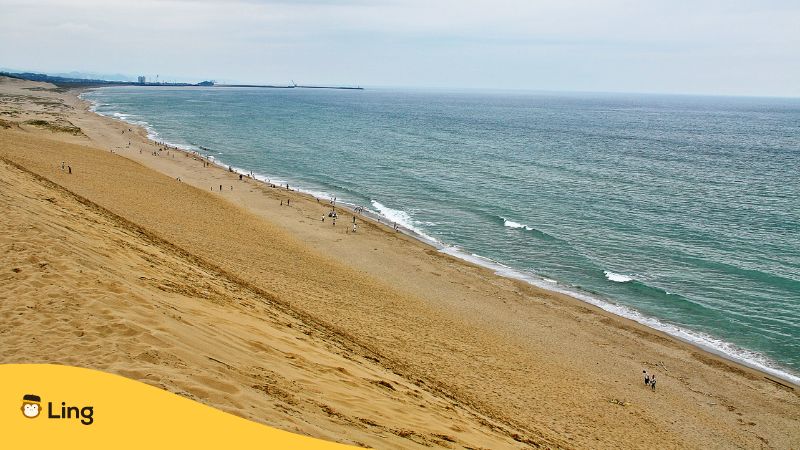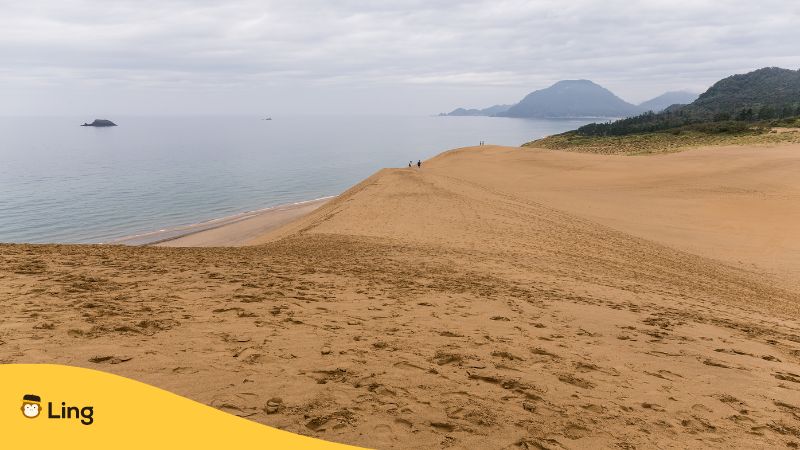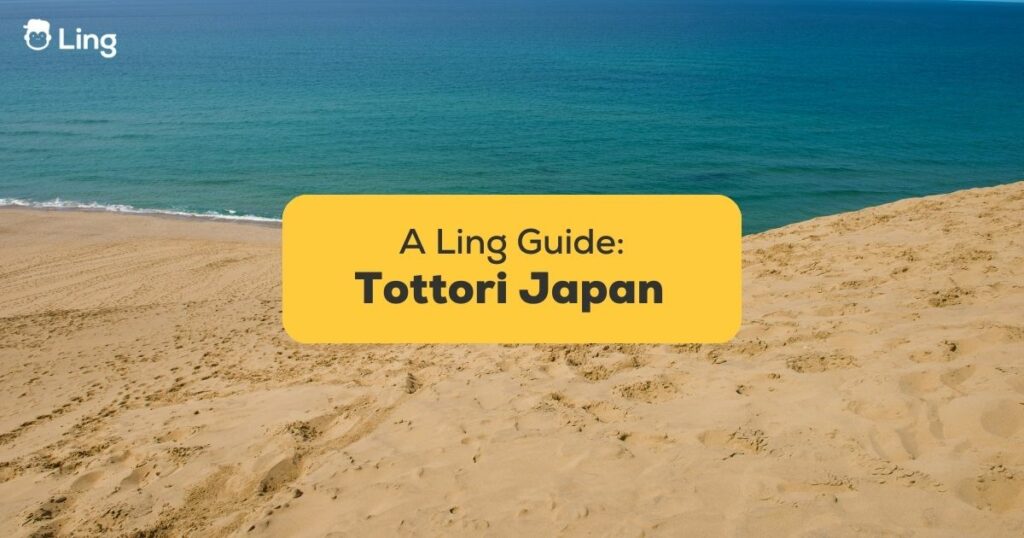Ever had dreams of wandering through the Sahara or some other desert spot, all Lawrence of Arabia style? Well, you might just live that out then more when you visit Tottori Japan! While the Tottori prefecture may not exactly be on everyone’s travel list when they say “Japan,” you might be surprised that this spot actually has a relatively unique view – a rugged coastline combined with sweeping sand dunes!
I still remember the first time I laid eyes on those monumental sand mountains. During my stay in Japan as an exchange language teacher, I took a weekend trip to Tottori on a whim. Emerging from the train station, the grand dunes rising in the distance above coastal villages stole my breath. I knew right then this prefecture would be no ordinary destination. Unlike the crowded streets of Tokyo, Tottori felt like a vast wilderness waiting to be explored.
And to be honest? During my travels crisscrossing Japan, no other region has continued to amaze me with such diverse topography – all beautifully unspoiled and untamed. In this post, let’s get to know more about this prefecture and a few Japanese expressions every traveler should know. Let’s begin!
Table Of Contents
Where Is Tottori?
Tucked away in Honshu’s north coastal region facing the Sea of Japan lies the rural prefecture of Tottori. As the least populous and perhaps most underrated region in Japan, Tottori flies under the radar of most international visitors. But adventure seekers who make the journey to this remote locale get rewarded with gorgeous scenery ripe for hiking, biking, surfing, and more against a backdrop of the Tottori Sand Dunes and Mt. Daisen.
Within Tottori, the largest city and capital is the port city of Tottori along the central-eastern coast. But the top destination for visitors remains the Tottori Sand Dunes spanning across the city of Tottori’s northern neighborhoods with riding camels wandering near the beaches. The prefecture’s two other major cities – Yonago and Kurayoshi – also attract travelers with vibrant downtowns and proximity to sites like Daisen-Oki National Park.
But outside these population hubs, Tottori’s endless coastlines, rolling green hills and farmland, lush rural valleys, and rugged mountain terrain stay blissfully undeveloped. All are waiting for adventurous spirits who make the journey out of Japan’s heartland.
How To Get To And From Tottori?
By Air
The easiest way to reach Tottori is to book a flight from Tokyo Haneda Airport to Tottori Airport. Multiple airlines offer daily 1-hour and 30-minute flights. From Tottori Airport, take a 20-minute shuttle bus straight to JR Tottori Station in the city center.
By Bus
You can also opt to take a long-distance highway bus from Tokyo Station Yaesu Exit to JR Tottori Station. But buses take over 7 hours to reach Tottori and can cost more than flights. Major bus operators with Tokyo to Tottori routes include Nishinihon JR Bus and Willer Express.
By Train
If you have a Japan Rail Pass, you can take the Shinkansen bullet train from Tokyo Station to Tottori with a transfer to Himeji. Here is a sample efficient route:
- At Tokyo Station, board the Nozomi 107 bullet train heading towards Hakata.
- After 3 hours, get off at Himeji Station.
- Transfer at Himeji Station to the Limited Express Super Hakuto 7 train bound for Tottori.
- After 2 more hours, alight at JR Tottori Station.
- From Tottori Station, access the local bus network or taxi stands to reach your hotel.
You can also catch trains headed towards the Okayama or Kyoto regions with a transfer to the Super Hakuto train along the way. Total trip time averages 5-6 hours.

5 Best Spots In Tottori Japan
Mitokusan Sanbutsuji Temple
Address: 1010 Mitoku, Misasa, Tōhaku District, Tottori 682-0132, Japan
Entrance Fee:
Main Hall – Adults: 400 yen / Elementary to High School Students: 200 yen
Nageiredo Hall – Adults: 1,200 yen / Elementary to High School Students: 600 yen
Hidden high atop Mount Mitoku lies the awe-inspiring Sanbutsuji Temple, part of a mountain ascetic site tied to the mystical Shugendo Buddhist sect. The highlight remains the Nageiredo Hall, precariously wedged into a cliffside cavern 900 meters above sea level.
Recognized as a National Treasure, the miraculous Nageiredo structure almost appears suspended in thin air. Local legend claims it was thrown or projected through spiritual powers into the mountainside to be closer to the deities above. Though the exact origins remain shrouded in myth, historians trace initial construction back to at least the 12th century.
Reaching the Sanbutsuji Temple requires a steep 90 to 120-minute uphill climb on uneven stone steps and dirt trails from the base parking lot. Sturdy shoes, gloves, hiking poles, and torches prove essential for the trek and vertigo-inducing lookouts. Also, the local government requires a group of two or more people before climbing.
Not into sweating so much? You can also admire spectacular views of the suspended temple from vistas along the mountain roads below.
Daisenji Temple
Address: 9 Daisen, Saihaku District, Tottori 689-3318, Japan
Entrance Fee: Adult: 300 yen / Child: 200 yen
Nestled on the forested northern slope of Mt. Daisen lies Daisenji, an ancient Buddhist temple dating back to the Heian Era over 1,000 years ago. Originally constructed as a religious retreat for monk ascetic training, Daisenji once constituted over 100 temple structures housing some 3,000 monks.
Today, just a handful of the Daisenji complex structures remain intact after destruction by fires and other natural disasters over the centuries. The recently restored Main Hall now safeguards important cultural artifacts like the Jizo Bosatsu statue and wooden carvings of Amida Buddha. According to the locals, many consider this spot as a modern training dojo.
@hlfiona 📍Tottori prefecture. Largest sand dunes right here in Japan! #onlyinjapan #tottori #japantravel #thingstodoinjapan
♬ Energetic And Happy – KLM Music
Tottori Sand Dunes
Address: 2164-971 Fukubecho Yuyama, Tottori, 689-0105, Japan
Entrance Fee: FREE
No trip to Tottori prefecture would be complete without a visit to the largest sand dunes in Japan – the Tottori Sand Dunes. Stretching roughly 15 kilometers along the coast north of Tottori city, these monumental sand mountains tower up to 50 meters high, leading straight to the Sea of Japan shoreline.
Around the sand dunes, riders on camels imported from the Sahara escort visitors on 30-minute jaunts through the sandy landscapes reminiscent of the Middle East. For the more adventurous, sandboarding rides down the dunes’ steep faces promise adrenaline-filled fun.
Or take a lift up to the Sakyu Center observation deck perched atop the dunes to admire the wind-rippled beauty without the sweat or sand in your shoes! Access the deck viewpoint via a scenic chairlift ride for panoramic vistas over the sandy expanse.
If you have some extra time, take a short walk from the Sakyu Center to the Tottori Sand Dunes Museum (Unlimited one-day access for 600 yen). This facility features detailed exhibits on the geology, history, and ecology of the sand dunes so you can fully understand the forces that created this magnificent natural phenomenon.
Hakuto Shrine
Address: 603 Hakuto, Tottori, 689-0206, Japan
Entrance Fees: FREE
Tottori claims home to Japan’s oldest love story at Hakuto Shrine in central Tottori City. As the name “Hakuto” or “White Rabbit” suggests, this unique shrine venerates a white rabbit god with an auspicious legend of playing matchmaker.
Legend tells of a wounded white rabbit nursed back to health by the deity Okuninushi-no-mikoto. To display gratitude, the loyal rabbit promised to pair Okuninushi with Yakami-hime, a princess renowned across the land for unparalleled beauty. Today, countless romantics flock to Hakuto Shrine to seek their own auspicious matchmaking blessings from the celestial white rabbit.
Kannon-in Temple
Address: 162 Uemachi, Tottori, 680-0015, Japan
Entrance Fees: 650 yen
Nestled on the southeast outskirts of central Tottori lies Kannon-in, a serene Buddhist temple built in the early Edo period by the prominent Ikeda clan who ruled the Tottori Domain for generations. As part of the Tendai sect, Kannon-in Temple venerates Kannon, the goddess of mercy and compassion in Buddhist traditions.
But most visitors come to admire the sprawling Japanese landscape garden flanking the main hall. Here a large pond dotted with symbolic islands extends across manicured lawns shaded by mature pines and maples. Two islets represent the iconic crane and turtle, both auspicious symbols of longevity and health frequently incorporated in contemplative gardens.
From the temple’s wooden verandah, guests can sip freshly brewed matcha green tea while taking in spectacular views over this harmonious oasis. The contrast of velvety moss and gnarled roots juxtaposed against smooth stones proves particularly captivating.

Japanese Phrases For Your Tottori Travel
Even if you don’t speak Japanese, learning a few key phrases can make navigating Tottori much smoother and more enjoyable. Here are some of the most helpful expressions to know:
| English | Japanese Script | Japanese Pronunciation |
|---|---|---|
| Excuse me | すみません | Sumimasen |
| Thank you | ありがとうございます | Arigatō gozaimasu |
| Hello | こんにちは | Konnichiwa |
| Goodbye | さようなら | Sayonara |
| Sorry | ごめんください | Gomen kudasai |
| I don’t understand | わかりません | Wakarimasen |
| Do you speak English? | 英語を話しますか? | Eigo o hanashimaska? |
| How much is this? | これはいくらですか? | Kore wa ikura desuka? |
I feel you – Japanese seems CRAZY difficult with all the bowing, fancy grammar, and complex characters. Just wrapping your mouth around the words can twist your tongue in knots! But here’s a local Tottori secret: even just a couple of phrases and greetings, plus some smiles, go a long way!
Don’t stress about pronunciation perfection. The locals will give you an A+ for effort and appreciate you trying to connect through their native lingo. Start with the basics like: “Hello,” “Thank you,” and “Excuse me” – then build from there!
Learn Japanese With Ling
As you can see, Tottori delivers nonstop awesomeness for thrill-seeking travelers. We’re talking hall of fame level landscapes and active escapades. For bite-sized Japanese lessons tailored to travel in Japan, I highly recommend downloading the Ling app.
Ling offers fun, quick tutorials on essential travel expressions as well as etiquette tips for interacting smoothly with Japanese people. The best part? You can try it out for FREE! Download it today to get started on your first few lessons.



































































